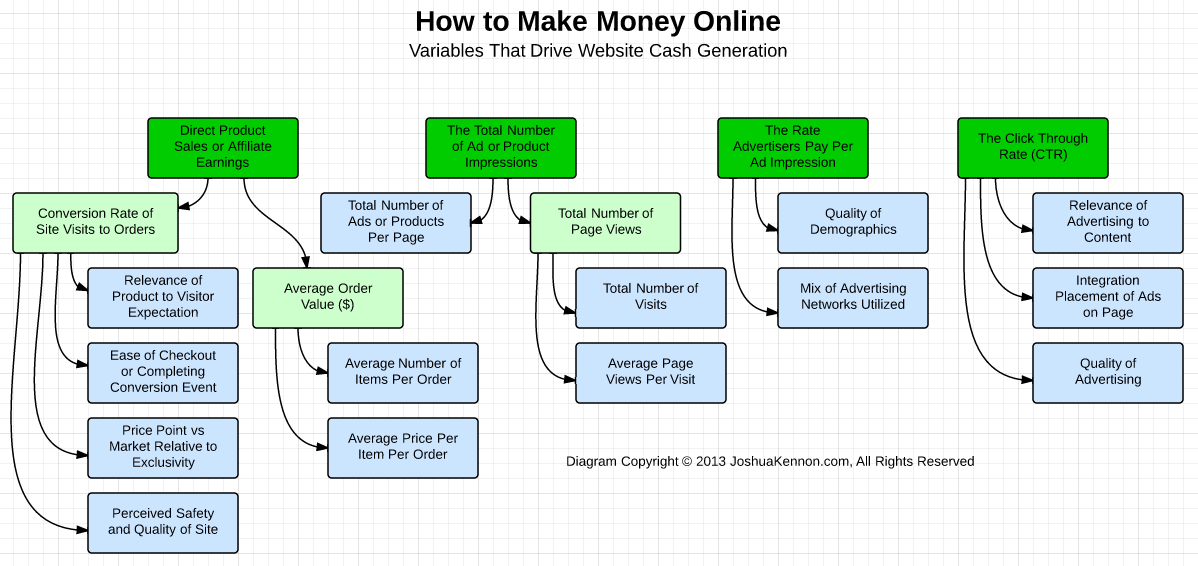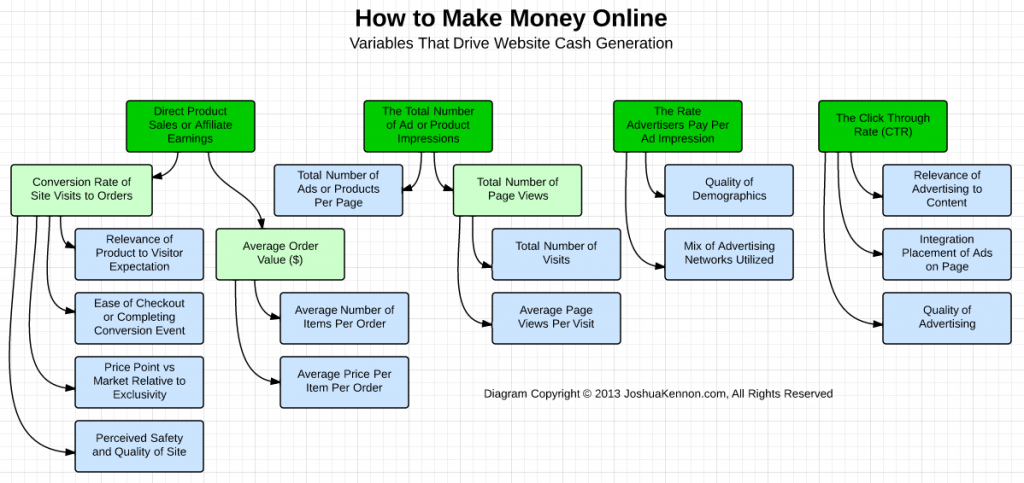I am often asked questions about how to make money online and politely dodge them as it’s a vast topic, every bit as complex as investing, that could put me at a competitive disadvantage were I to discuss our techniques in the level of detail that I often require of my writing.
Earlier today, one of our good friends wrote me asking about how to make money online because he’s started a new blog and wants to at least generate enough advertising income to make it worth the effort and expense. Without thinking much about it, I wrote out my thoughts in a Google Plus conversation, and then realized I had inadvertently responded to hundreds of you who have sent in this very question.
[mainbodyad]I took some time to remove the specific numbers (I had pointed out one article on this blog that generates $1,000 in cash per year from the advertisements alone but highlighting it would result in competition) and am going to turn it into a high level, abstract view explaining to you the underlying variables that are responsible for making money from a website, whether it is a blog, an online retailer, or a corporate site that you use to secure work (such as a freelance artist).
I’m going to treat this as a scientific breakdown. It is important to note that this conversation is focused solely on the cash generation side of the equation. There are many other factors that should be included in your analysis of a business model, including capital requirements, cash conversion cycle, supplier availability, contingent liabilities and risk exposure, technical matters such as platform selection, sales compensation models, etc. Those all matter. The purpose of this post is to explain to you the things that are causing greenbacks to get deposited into your checking account, whether you are trying to run a successful blog or selling antique replica model trains.
The 4 Variables That Matter To You If You Want to Make Money Online
There are four major variables that matter if you want to make money online from your website. If you are an investor (as many of the people on this site are), the mathematical relationship between these variables is very comparable to the DuPont Return on Equity formula. The mechanics of interaction are almost identical, with the terminology slightly altered.
The variables for making money online are:
- Direct Product Sales or Affiliate Earnings
- The Total Number of Ad or Product Impressions
- The Rate Advertisers Pay Per Ad Impression
- The Click Through Rate (CTR)
These four variables, working together, add up to the total amount of cash generated by your site in a given period. Which variables require your focus depends upon the business model to which you have hitched your wagon.
Each of these variables has sub-variables that can be managed by you, the site owner. Your job is to focus on the the blue boxes, modifying these levers to the best of your ability (or the ability of the most talented person you can afford to hire). When that happens, the green boxes naturally improve. In other words, you cannot work on the green boxes directly; those green boxes are the natural by-product of what is happening below them. (I’ve explain this concept in the past on the site; how you can’t, actually, bake a pie. Instead, you can combine butter, sugar, flour, and shortening to create a crust, fill it with apple slices, and put it in the oven. The pie is the outcome; the by-product of the process. Thus, to make the perfect pie, you have to focus on the sub-processes and the pie will take care of itself.)
There are two broad metrics I use that capture the performance of the above diagram, both for my intellectual property and my retail businesses:
- Total Revenue Generated Per 1,000 Page Views
- Total Page Views Per Week
These are my preferred tools when doing back-of-the-envelope calculations because I can use them as a rough proxy to gauge what is happening to the underlying variables that drive cash generation. Each month is compared to the exact same period in the prior year. I can very quickly spot slips, while ignoring the inevitable fluctuations that happen with seasonal shifts in weather, national news, and the economy.
On some sites, especially those that use a no-page view model such as Ajax-driven refreshes, you’d have to lose the focus on page views and instead focus on “events”, which would need to be clearly defined (e.g., clicking to view a particular SKU). That’s a technological consideration that doesn’t apply to most sites so I’m ignoring it for now, but the concept would remain the same.
Looking at How to Make Money Online from the Perspective of a Retail Site Owner
Using my diagram, if I were going to start a retailer that sold stuffed bunny rabbits, I am not going to permit any external advertising. That means, my focus is going to come down to three things:
- Total page views
- Total conversions (orders) generated per visit
- Average order value
Those are my main green boxes. That means I’m going to have to look below them to focus on the things I can control.
For example, there are only two ways it is mathematically possible to increase average order value. You have to do one of two things:
- Increase the average amount per item in an order
- Increase the total number of items in an order
That’s it. There is no other possible way to increase the value of an order. Every action I take must be justified on the grounds that it is going to improve one of those two numbers. This is why it is important to understand your strategy. It will influence your site design and how you approach your customer.
At one of my companies, one of the first things we did was introduce “revenue enhancers” – small $10 or less items that got added onto the sale as an impulse buy but that enjoyed 90%+ gross margins. In the early days, this generated thousands upon thousands of dollars in free money per year for me to fund investments and take out of the business as dividends. In that case, we were attempting to increase the total number of items added to an order. In years when we have an exclusive product that is in demand, we can increase the overall prices, or introducer higher priced goods, to drive up the average item amount.
Looking at How to Make Money Online from the Perspective of a Blogger
Imagine you wanted to run a successful blog. I’ve been doing this for a long time – my household generates a lot of annual page views, some of which come from sites you’ve never even heard about that I started back when I was younger as a hobby. For me, I don’t actually recommend it as a business. I stumbled into it and made it work because I have a knack for writing clearly, and very quickly. There are much easier ways to generate cash that require less time.
Still, if you enjoy writing, it can be a fun experience. It is nice to know that if I were to wake up with no businesses, no investments, no employable skills, no house, no car, and no wallet, the spouse and I would still be getting checks from my copyrights that are far in excess of what the median American household earns per year for work done more than a decade ago. On the other hand, I don’t think you should ever consider this stable money. Ad rates are notoriously volatile and you can see significant fluctuations in short periods of time. I would never borrow money against an earnings stream produced by digital content, nor would I want to rely on it in any meaningful way were it my only source of cash generation. To do so would be a recipe for disaster, in my opinion.
[mainbodyad]Both the Saks business model (fewer transactions or clicks, higher totals per event) on a lucrative niche market site, and the Wal-Mart business model (many more clicks, lower total per event) on a broadly popular site that doesn’t monetize well can be very lucrative (look at what Michael K has achieved at Dlisted.com), but you need to be consistent and focus on what you are attempting to achieve.
(On a side note, the genius of businesses like Google, Facebook, SeekingAlpha, PlentyofFish, ad infinitum, is that they relied on user generated content to drive ever-increasing page views. Therefore, there was very little time, money, or effort required on the part of the site owner to build out the advertising inventory as the site users were doing it 24 hours a day, 7 days a week. In the case of Facebook, the users were doing it for free. In the case of Google, they were being offered part of the advertising money, which means there were few upfront costs, providing a negative cash conversion cycle.)
A Few Final Thoughts
Obviously, the topic is much more complex than this but in the past, I’ve explained to you how there are only two levers you can use to make your net worth increase. What I’m really doing here is explaining to you the four factors that are driving the first lever – bringing more cash in the door. By reverse engineering it, and breaking it down to the simplest variable, you can see how it becomes fairly easy from a strategy point of view. You at least know where to start, and what can be done to improve performance. It’s a framework that puts you in control by identifying your tools.




